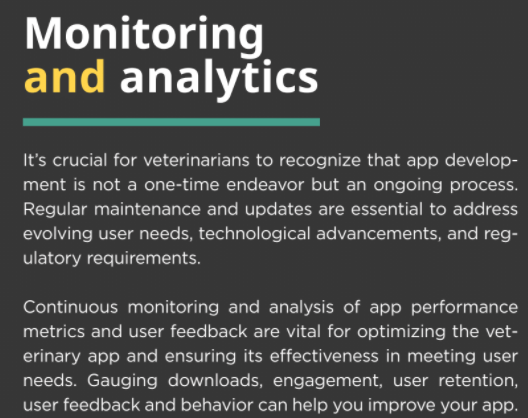Developing custom veterinary apps offers a valuable opportunity to improve and streamline your practice, elevate patient care, and foster stronger connections with clients.
In today’s digital age, mobile applications have become invaluable tools for businesses across various industries, including veterinary practice. These apps offer a range of functions that can streamline processes, improve communication, and enhance the overall efficiency of veterinary clinics and professionals. Many veterinarians are recognizing the significance of mobile apps in modern veterinary practice, and are exploring the development of custom applications tailored to their specific needs and requirements. This article looks at how you can do the same.
Importance of mobile apps in veterinary practice
Mobile apps have revolutionized the way veterinary professionals manage their clinics, interact with clients, and provide care to their animal patients. With the widespread use of smartphones and tablets, these apps offer unparalleled convenience and accessibility, allowing veterinarians to stay connected and productive, even while on the go. From appointment scheduling and medical record management to educational resources and telemedicine capabilities, mobile apps play a crucial role in modernizing and optimizing veterinary services.
Benefits of developing custom veterinary apps
- Personalized solutions: Custom veterinary apps can be tailored to meet the unique needs and workflows of individual clinics and practitioners. By developing a custom app, veterinarians can create a solution that aligns perfectly with their practice goals, preferences, and specialty areas.
- Improved client engagement: Mobile apps provide a direct and convenient channel for communication between veterinarians and their clients. Through features such as appointment booking, reminders, and real-time messaging, custom apps can enhance client engagement, foster stronger relationships, and encourage proactive pet care.
- Enhanced practice efficiency: By automating routine tasks and streamlining administrative processes, custom veterinary apps can significantly improve practice efficiency. From managing patient records and inventory to processing payments and generating reports, these apps enable veterinarians to save time, reduce errors, and focus on delivering high quality care.
- Access to educational resources: Veterinary apps can serve as valuable educational tools for both professionals and pet owners. Including features such as medical reference guides, training videos, and informational articles means custom apps can empower users with knowledge and resources to make informed decisions about animal health and wellness.
- Telemedicine capabilities: In an era of increasing demand for telemedicine services, custom veterinary apps can facilitate remote consultations and virtual care delivery. Through secure video conferencing, messaging, and image sharing functions, veterinarians can provide timely advice, diagnosis, and treatment recommendations to clients, regardless of their location.
Understanding the needs of the veterinary practice
Before diving into the development process, it’s crucial to have a clear understanding of the needs and requirements of the veterinary practice. This involves identifying the target audience, assessing the specific challenges faced by veterinarians, and researching existing apps to gather insights into their functions and features.
1. Identifying the target audience
- The primary audience for the app includes veterinarians, veterinary technicians, and other staff members involved in animal care and practice management.
- Depending on the app’s purpose, pet owners may also be a target audience. Consider their preferences, expectations, and pain points when designing the app.
2. Assessing specific needs and challenges
- Streamlining the appointment scheduling process to minimize wait times and optimize clinic workflow
- Developing a secure and user-friendly system for storing, accessing, and updating patient medical records
- Enhancing communication channels between veterinarians and clients to provide timely updates, reminders, and educational resources
- Implementing tools for tracking inventory levels, ordering supplies, and managing medications and equipment
- Introducing telemedicine capabilities to facilitate virtual consultations and remote monitoring of patients.
Planning and conceptualization
Once the needs and requirements of the practice have been identified, the next step is to plan and conceptualize the app. This phase involves defining the goals and objectives, creating a detailed feature list, and developing a rough prototype to visualize the app’s functions and user interface.
1. Defining the apps goals and objectives
- Clear purpose: Clearly define the primary purpose of the app, whether it’s to streamline clinic operations, improve client communication, or enhance patient care.
- Specific objectives: Establish the specific objectives the app aims to achieve, such as increasing appointment bookings, reducing administrative tasks, or enhancing diagnostic capabilities.
- Measurable outcomes: Identify key performance indicators (KPIs) to measure the app’s success, such as user engagement metrics, efficiency improvements, or revenue growth.
2. Creating a detailed feature list based on needs
- Compile a list of essential features based on the identified needs and challenges as outlined above. This may include appointment scheduling, medical records management, client communication tools, and telemedicine capabilities.
- Prioritize features based on their importance and impact on achieving the app’s goals and objectives. Consider categorizing features into must-have, nice-to-have, and future development phases.
- Gather input from veterinary professionals and potential users to ensure the feature list aligns with their preferences, workflows, and pain points.
3. Choosing development platforms and tools
After establishing the goals and features of the veterinary app, the next step is to select the appropriate development platforms and tools. This involves evaluating different options for app development, choosing the right technologies, and deciding between app-building platforms or custom development.
Consider the target audience and market share when deciding between iOS and Android platforms. Evaluate factors such as device compatibility, user demographics, and revenue models (App Store vs. Google Play). Explore cross-platform frameworks like React Native, Flutter, or Xamarin, which allow developers to write code once and deploy it across multiple platforms. Assess the trade-offs in terms of performance, native capabilities, and development complexity.
Assess the feasibility of using app-building platforms or app generators, which offer drag-and-drop interfaces and pre-built templates for rapid app development. Evaluate the benefits of custom development for greater control over the app’s design, functionality, and performance. Consider factors such as cost, flexibility, and customization options.
4. Designing the user Interface (UI) and user experience (UX)
Once the development platforms and tools are chosen, the focus shifts to designing the user interface (UI) and user experience (UX) of the veterinary app. This stage involves creating an intuitive, visually appealing interface that enhances usability and ensures a positive experience for users. Its important to create an intuitive and user-friendly interface. Incorporating branding elements and visual Identity is also a valuable part of the app development process. You also need to focus on accessibility and ease of navigation.
5. Development and testing
With the design phase complete, the focus shifts to the development and testing of the veterinary app. This phase includes processes such as coding and programming the app features by employing frontend development, backend development, and integration of different features. This is followed by conducting rigorous testing for functionality, usability, and performance, and then iterative development based on user feedback and testing results.
6. Integration with veterinary systems and APIs
Once the development and testing phases are complete, the next step is to seamlessly integrate the veterinary app with existing management systems, implementing secure data transfer and storage protocols, and leveraging APIs for additional functionalities and data sources.
7. Deployment and distribution
After the development phase, the deployment and distribution of the veterinary app are crucial to make it accessible to users and maximize its reach and impact.
Publishing on app stores such as Apple App Store and Google Play Store is an important step to making the app available online. Next comes implementing effective marketing strategies for app promotion, which includes targeted advertising; forging strategic partnerships with veterinary clinics, pet care organizations, industry influencers, and professional associations to promote the app to their networks and communities; and collaborating on joint marketing initiatives, sponsorships, or co-branded promotions to increase visibility and credibility.
App Store Optimization (ASO) is another important part of making sure your app has maximum exposure. And finally, providing ongoing support and updates for the app can make you stay ahead of your competitors.


Final words
The development of custom veterinary apps presents a valuable opportunity to drive positive outcomes, elevate patient care, and foster stronger connections with pet owners. The nitty-gritty of app development for veterinary practitioners can, of course, be handled by app developers but having some know-how of the process will come in handy. By embracing technology as a catalyst for innovation and improvement, veterinarians can lead the way towards a future of enhanced veterinary care and practice excellence.







